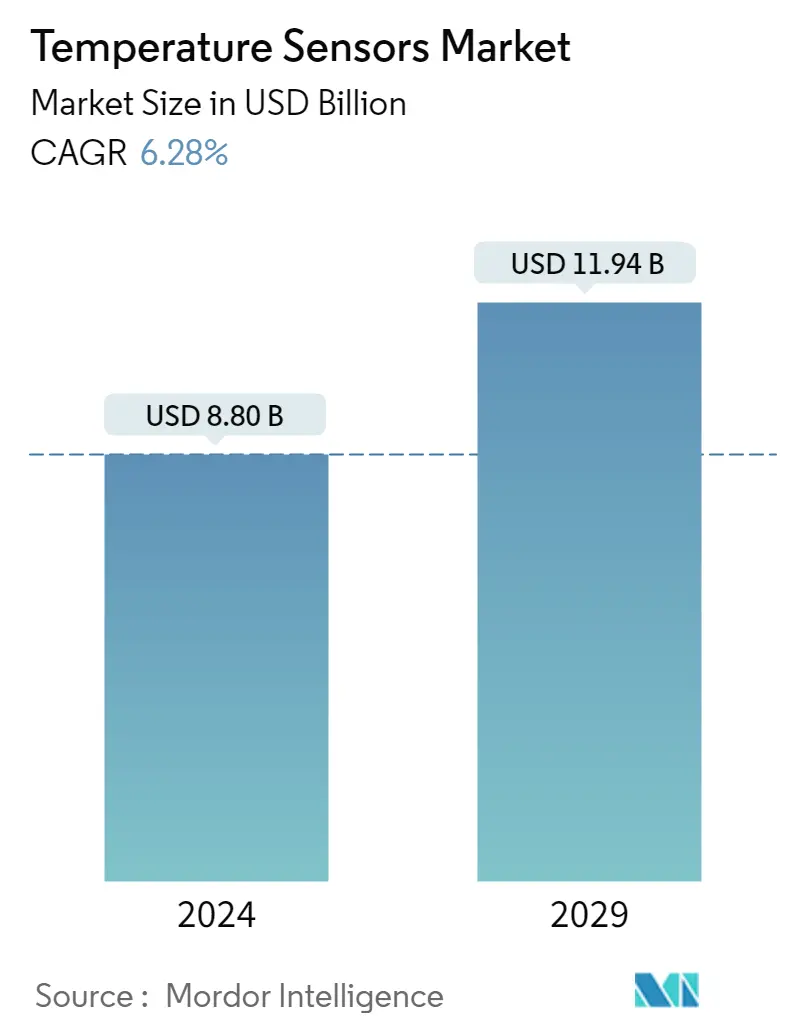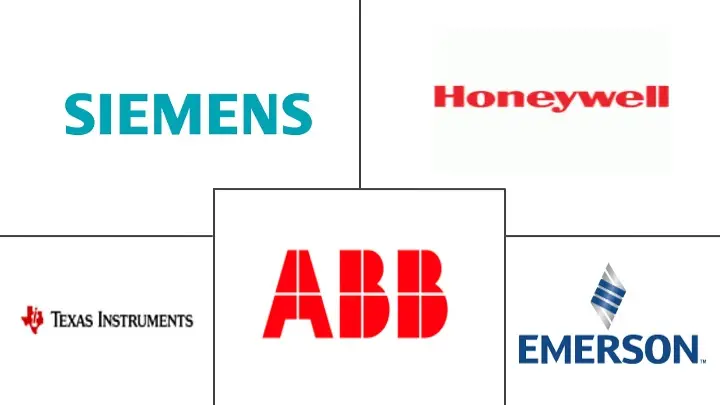Market Size of Temperature Sensors Industry

| Study Period | 2019 - 2029 |
| Market Size (2024) | USD 8.80 Billion |
| Market Size (2029) | USD 11.94 Billion |
| CAGR (2024 - 2029) | 6.28 % |
| Fastest Growing Market | Asia Pacific |
| Largest Market | North America |
Major Players
*Disclaimer: Major Players sorted in no particular order |
Temperature Sensors Market Analysis
The Temperature Sensors Market size is estimated at USD 8.80 billion in 2024, and is expected to reach USD 11.94 billion by 2029, growing at a CAGR of 6.28% during the forecast period (2024-2029).
Temperature sensors employed using IoT connectivity are expected to speed up owing to the increasing need for COVID-19 testing and screening. Semtech and Polysense Technologies collaborated to develop temperature monitoring devices for a human body based on Semtech's LoRa LPWAN. The company's temperature sensors would offer frontline healthcare workers real-time data for faster screening of individuals with a high temperature.
- The growing adoption of HVAC modules in the automotive industry and industrial end users applications are some of the major driving factors of the temperature sensor market.
- Growing demand for consumer electronics is also expected to boost market growth further. An increase in the global focus on security and surveillance and various government initiatives toward safety norms is also expected to promote the adoption of the temperature sensor market.
- The growing adoption of wireless temperature sensors in various industries is mainly attributed to the applications of non-contact measurement features, which enable them to reach locations where a device's physical deployment is impossible.
- Various applications of temperature sensors, including flare systems, wellhead tanks, chemical tanks, pipeline data collection, and compressors, are among some of the multiple applications of temperature sensors in the oil and gas industry. The applications of temperature sensors in the oil and gas industry are considered critical. Installing a wired device inside a pipe or a tank would be inefficient if the operating temperature is relatively high.
- Further, the nature of the industry makes the usage of temperature sensors crucial, as it is essential to monitor the temperature changes in these lines and maintain safe working conditions. The super-heated steam and water pipelines are extended, and accidents in these may lead to the damage and loss of other assets, which is one of the driving factors for the demand and regulatory needs.
- Trends in the personal computing industry, such as smaller system sizes, faster processors, and the need to support more advanced applications, make monitoring and controlling heat imperative. This trend, coupled with robust sales and advancements in desktop and portable computers, is likely to continue to support the growth of temperature sensors.
- One of Honor's recently announced smartphones, the Honor Play 4 Pro, is available with an infrared temperature sensor. In the era of a COVID-19 pandemic, when a high temperature could be a sign of being ill with COVID-19, it could be a helpful smartphone feature. According to Honor, the sensor works between temperatures of -20 degrees Celsius and 100 degrees Celsius (approximately -4 to 212 degrees Fahrenheit), which is more than enough to cover the human body's range of potential temperatures, and it can sense temperatures down to the tenth of a degree.
Temperature Sensors Industry Segmentation
Temperature sensors are devices used to measure temperature readings via electrical signals. The sensor is made of two metals that generate electrical voltage or resistance once it notices a temperature change. The temperature sensors have various sensor types based on the technology type, such as Infrared, Thermocouple, Resistance Temperature Detectors (RTD), thermistors, and others. The report describes the type of sensors, such as wired and wireless, and also provides the study of output, which are analog and digital. The end-user industry comprises temperature sensor applications and majorly includes Chemical and Petrochemical, Oil and Gas, Metal and Mining, Power Generation, Food and Beverage, Automotive, Medical, Aerospace & Military, and others.
The Temperature Sensors market is segmented by Type (Wired, Wireless), Technology (Infrared, Thermocouple, Resistance Temperature Detectors, Thermistor, Temperature Transmitters, Integrated Circuit, Fiber optics), End-user Industry (Chemical and Petrochemical, Oil and Gas, Metal and Mining, Power Generation, Food and Beverage, Automotive, Medical, Consumer Electronics, Aerospace, and Military), and Geography (North America, Europe, Asia-Pacific, Latin America, MEA). The market sizes and forecasts are provided in terms of value (USD million) for all the above segments.
| Type | |
| Wired | |
| Wireless |
| Technology | |
| Infrared | |
| Thermocouple | |
| Resistance Temperature Detectors (RTD) | |
| Thermistor | |
| Temperature Transmitters | |
| Fiber Optic | |
| Others |
| End-User Industry | |
| Chemical and Petrochemical | |
| Oil and Gas | |
| Metal and Mining | |
| Power Generation | |
| Food and Beverage | |
| Automotive | |
| Medical | |
| Aerospace and Military | |
| Consumer Electronics | |
| Other End-User Industries |
| Geography | |||||||
| |||||||
| |||||||
| |||||||
| |||||||
|
Temperature Sensors Market Size Summary
The temperature sensors market is poised for significant growth, driven by the increasing integration of IoT connectivity and the rising demand for COVID-19 testing and screening solutions. Collaborations, such as those between Semtech and Polysense Technologies, are enhancing the capabilities of temperature sensors, providing real-time data to healthcare workers. The automotive and industrial sectors are major contributors to market expansion, with the adoption of HVAC modules and consumer electronics further propelling growth. The market is also benefiting from heightened security and surveillance needs, alongside government safety initiatives. Wireless temperature sensors, with their non-contact measurement features, are gaining traction across various industries, including oil and gas, where they are essential for monitoring high-temperature environments safely.
In North America, the temperature sensors market is experiencing robust growth due to substantial investments from established manufacturers and the region's significant role in the global oil supply. The healthcare sector's reliance on temperature sensors for various applications, such as cardiac monitoring, also supports market expansion. The competitive landscape is marked by high rivalry, with key players like Honeywell, Texas Instruments, and STMicroelectronics driving innovation and product differentiation. Recent advancements, such as Apple's integration of temperature sensors in its Apple Watch and OMEGA Engineering's clamp-on sensors for plastic pipes, highlight the ongoing technological developments in the market. These trends, coupled with the increasing demand for infrared temperature sensors in manufacturing and defense, underscore the market's dynamic nature and its potential for continued growth.
Temperature Sensors Market Size - Table of Contents
-
1. MARKET DYNAMICS
-
1.1 Market Overview
-
1.2 Industry Attractiveness - Porter Five Forces
-
1.2.1 Bargaining Power of Suppliers
-
1.2.2 Bargaining Power of Buyers
-
1.2.3 Threat of New Entrants
-
1.2.4 Intensity of Competitive Rivalry
-
1.2.5 Threat of Substitute Products
-
-
1.3 Industry Value Chain Analysis
-
1.4 Assessment of the Impact of COVID-19 on the Market
-
-
2. MARKET SEGMENTATION
-
2.1 Type
-
2.1.1 Wired
-
2.1.2 Wireless
-
-
2.2 Technology
-
2.2.1 Infrared
-
2.2.2 Thermocouple
-
2.2.3 Resistance Temperature Detectors (RTD)
-
2.2.4 Thermistor
-
2.2.5 Temperature Transmitters
-
2.2.6 Fiber Optic
-
2.2.7 Others
-
-
2.3 End-User Industry
-
2.3.1 Chemical and Petrochemical
-
2.3.2 Oil and Gas
-
2.3.3 Metal and Mining
-
2.3.4 Power Generation
-
2.3.5 Food and Beverage
-
2.3.6 Automotive
-
2.3.7 Medical
-
2.3.8 Aerospace and Military
-
2.3.9 Consumer Electronics
-
2.3.10 Other End-User Industries
-
-
2.4 Geography
-
2.4.1 North America
-
2.4.1.1 United States
-
2.4.1.2 Canada
-
-
2.4.2 Europe
-
2.4.2.1 United Kingdom
-
2.4.2.2 Germany
-
2.4.2.3 France
-
2.4.2.4 Rest of Europe
-
-
2.4.3 Asia Pacific
-
2.4.3.1 China
-
2.4.3.2 India
-
2.4.3.3 Japan
-
2.4.3.4 South Korea
-
2.4.3.5 Rest of Asia Pacific
-
-
2.4.4 Latin America
-
2.4.4.1 Brazil
-
2.4.4.2 Mexico
-
2.4.4.3 Rest of Latin America
-
-
2.4.5 Middle East and Africa
-
2.4.5.1 United Arab Emirates
-
2.4.5.2 Saudi Arabia
-
2.4.5.3 Rest of Middle East and Africa
-
-
-
Temperature Sensors Market Size FAQs
How big is the Temperature Sensors Market?
The Temperature Sensors Market size is expected to reach USD 8.80 billion in 2024 and grow at a CAGR of 6.28% to reach USD 11.94 billion by 2029.
What is the current Temperature Sensors Market size?
In 2024, the Temperature Sensors Market size is expected to reach USD 8.80 billion.

